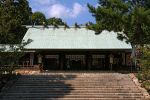The modern city of Kobe lies between the Rokkosan 六甲山 mountains and the sea. In a previous post, we wrote about the megaliths of Rokkosan. These mountains are the locale of a fascinating story with both historical and linguistic interest.
Hotsuma History. During the times of Amateru Amakami in the Hotsuma Tsutae document, the mountains were known as Mukoyama, and the peak as Mukatsu-mine. The land of Muko was the domain of the Kanasaki family. When Isanami and Isanagi were unable to keep their first-born daughter Hiruko, they sent her to Kanasaki for fostering. There, Hiruko was lovingly raised and taught the art of waka poetry. Hiruko became so skilled with the kototama word power of waka that she became known as Wakahime. The area of Muko is called Hirota, perhaps because of her fostering. For his kindness, Kanasaki is known as Sumiyoshi Kami.
Wakahime was the elder sister of Amateru. Amateru led his people for many long years. When he felt his life’s end nearing, he sent his beloved wife Seoritsuhime to Hirota. There, she peacefully passed her remaining years in these mountains until “her spirit ascended.”
Linguistic Changes. Seoritsuhime is Mukatsuhime. The latter name appears in several places. In the Takenouchi Documents, it is アマサカリ ヒニ ムカイツ ヒメ ノミヒカリ アマツ ヒツギ アメノ スメラミコトAmasakari hini mukaitsu hime no mihikari amatsu hitsugi ame no sumera mikoto. The principal deity of Hirota Jinja is the aramitama wrathful spirit of Amateru Ookami, named ツキサカキ イツノ ミタマ アマサカル ムカツヒメ ノ ミコトTsukisakaki-itsuno mitama amasakaru mukatsuhime no mikoto.
How did Mukoyama change its name to Rokkosan? Please keep in mind that Woshite, the language of Hotsuma, was syllabic when spoken and when written in Woshite moji characters. Much later, Woshite writing fell out of use and was replaced by the kanji imported from China. The name Mukoyama 六甲山 when written in kanji can be read, Sino-wise, as Rokkosan.
Jinja Shrines. These shrines all have Mukatsuhime as their enshrined kami.
Hirota Jinja 広田神社 is located in Nishinomiya adjacent to Kobe.  While it enshrines the aramitama of Amateru-kami, Mukatsuhime, it also honors Sumiyoshi-kami whom we know as Kanasaki.
While it enshrines the aramitama of Amateru-kami, Mukatsuhime, it also honors Sumiyoshi-kami whom we know as Kanasaki.
Rokkohime Jinja 六甲比命神社 = Mukatsuhime Jinja. This shrine is on the mountain. Its deity is Benzaiten. [Wikipedia: Benzaiten is the goddess of everything that flows: water, time, words, speech, eloquence, music and by extension, knowledge.] Many believe that she is a later Buddhist version of Mukatsuhime.
Mukatsu Jinja (Ishi-no-houden) is a sessha sub-shrine of Hirota Jinja so that naturally, its gosaishin is Mukatsuhime.
Mukoyama Jinja 六甲山神社 is also a sessha with gosaishin Mukatsuhime.

Rokkohime Daizen Jinja 六甲比命大善神社 (ろっこうひめだいぜんじんじゃ) = Mukohime Jinja 六甲比女(むこひめ)神社. Benzaiten is worshipped there. There is a huge iwakura goshintai on which is carved the Buddhist Heart Sutra. Some say that Mukatsuhime’s tomb is here, and the Sutra is in her memory. This shrine is the okunoin of Tamonji Temple in Kobe which forms a line between the temple and the shrine to the summer solstice setting sun.

Photos are from Japanese Wikipedia.
Sources include
http://mysteryspot.main.jp/mysteryspot/rotukou3/rotukou3.htm
*


You must be logged in to post a comment.